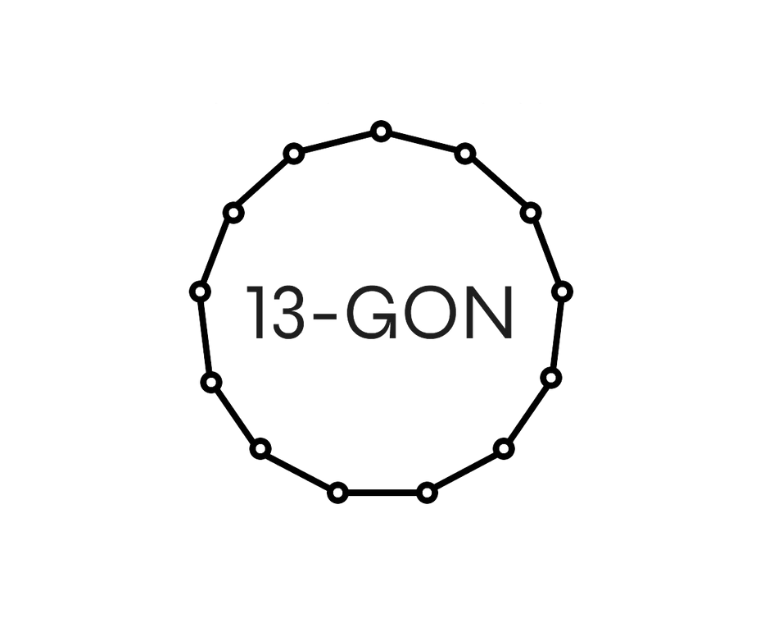
How to Find the Interior and Exterior Angles of a Regular 13-Sided Polygon
Polygons come in all shapes and sizes, from simple triangles to complex 13-sided figures known as tridecagons or triskaidecagons. While these names might sound intimidating, calculating their interior and exterior angles is straightforward when you understand the underlying formulas.
In this guide, we’ll explain:
✅ How to find the interior angles of a regular 13-sided polygon
✅ How to calculate the exterior angles
✅ Related polygon properties, such as sum of angles and real-world applications
Let’s break it down step by step!
Understanding a 13-Sided Polygon (Tridecagon)
A regular 13-sided polygon (tridecagon) has:
- 13 equal sides
- 13 equal angles
- Symmetry
Unlike irregular polygons, where angles and sides vary in length, a regular tridecagon allows us to use standard geometric formulas for calculations.
How to Find the Interior Angles of a Regular 13-Sided Polygon
Step 1: Use the Sum of Interior Angles Formula
The sum of the interior angles of any polygon is found using the formula:
Where n is the number of sides.
For a 13-sided polygon:
So, the total sum of all interior angles in a tridecagon is 1980°.
Step 2: Find Each Interior Angle (For a Regular 13-Sided Polygon)
Since a regular tridecagon has equal angles, we divide the total sum by 13:
Each interior angle of a regular 13-sided polygon is ≈ 152.31° (rounded to two decimal places).
How to Find the Exterior Angles of a Regular 13-Sided Polygon
Step 1: Use the Exterior Angle Formula
The exterior angle of any regular polygon is given by:
For a 13-sided polygon:
So, each exterior angle of a regular tridecagon is ≈ 27.69°.
Step 2: Check Your Answer Using the Interior-Exterior Angle Rule
For any polygon:
Checking our values:
✔️ The calculation is correct!
Quick Summary of Key Formulas
| Property | Formula | 13-Sided Polygon Calculation |
|---|---|---|
| Sum of Interior Angles | (n−2)×180∘(n - 2) \times 180^\circ | (13−2)×180=1980∘(13 - 2) \times 180 = 1980^\circ |
| Each Interior Angle (Regular Polygon) | Sum of Interior Anglesn\frac{\text{Sum of Interior Angles}}{n} | 1980∘13≈152.31∘\frac{1980^\circ}{13} \approx 152.31^\circ |
| Each Exterior Angle (Regular Polygon) | 360∘n\frac{360^\circ}{n} | 360∘13≈27.69∘\frac{360^\circ}{13} \approx 27.69^\circ |
Other Properties of a 13-Sided Polygon
1. Number of Diagonals
The number of diagonals in any polygon is given by:
For a 13-sided polygon:
A regular tridecagon has 65 diagonals.
2. Sum of Exterior Angles
The sum of exterior angles for any polygon is always 360°, no matter the number of sides!
3. Real-World Applications
While 13-sided polygons aren’t commonly seen in architecture or engineering, they appear in:
- Coin designs (Some countries use heptagonal and other multi-sided coins for better grip and anti-counterfeiting).
- Geometry problems in advanced mathematics and tessellations.
- Symmetric designs in tiling and artistic patterns.
Final Thoughts
A 13-sided polygon, or tridecagon, may sound complex, but calculating its angles is easy with the right formulas!
- Each interior angle in a regular tridecagon is ≈ 152.31°
- Each exterior angle is ≈ 27.69°
- The sum of interior angles is 1980°
- The sum of exterior angles is always 360°
Next time you encounter a polygon problem, just apply these simple formulas, and you’ll have the answer in no time!
Want to explore more polygon properties? Stay tuned for more in-depth geometry guides! 🚀